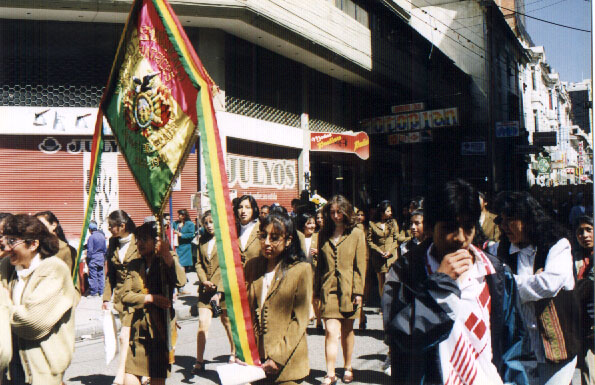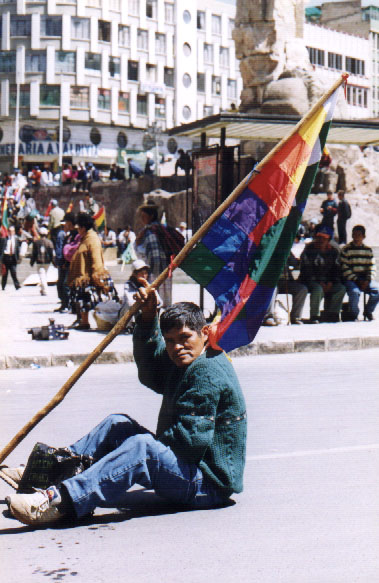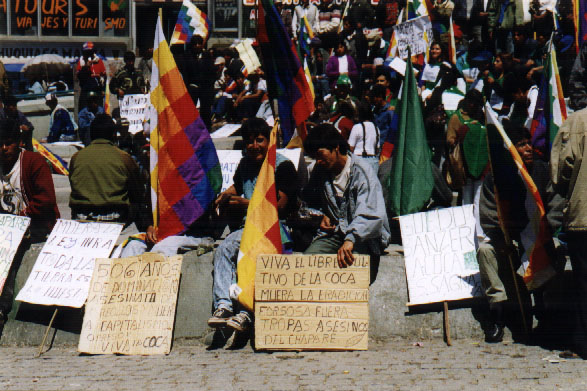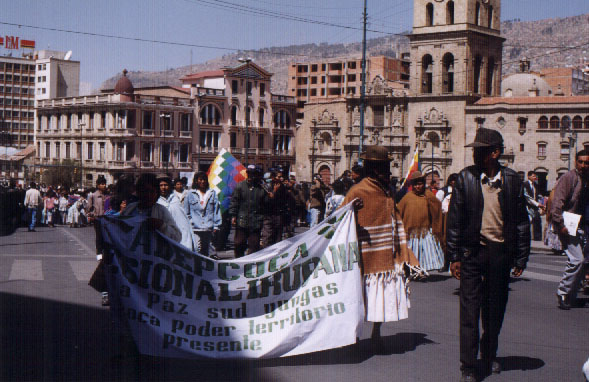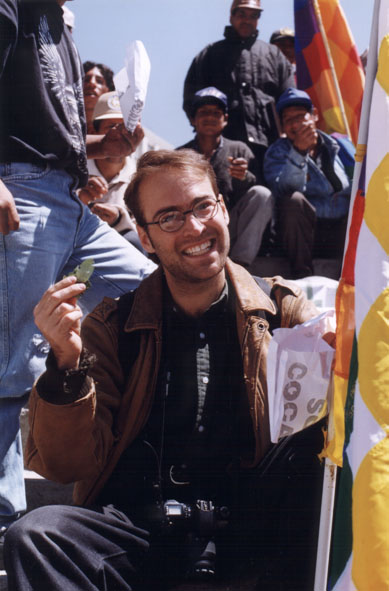

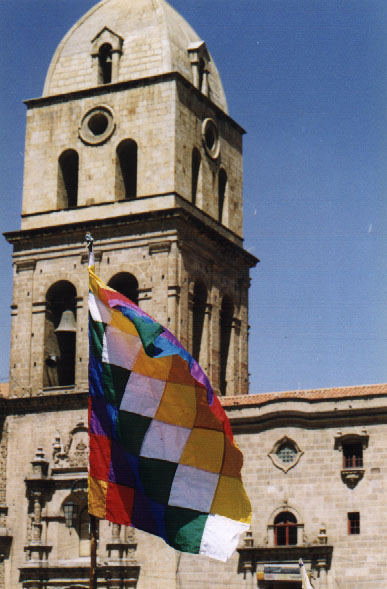 |
Campesino independence flag,
Plaza San Francisco, La Paz |
Susanne and I both had a hard time sleeping last night thanks to the infections we developed back in Cusco. My sinus infection seemed to be improving, but Susanne's cold still hadn't bottomed out yet. Because there was a good chance our Tiwanaku tour would be canceled again due to the cocaleros' blockade of the main road, I let Susanne sleep in while I checked with the hotel front desk. Before I could even get the question out of my mouth, one of the women behind the counter shook her head and said, "I am so sorry... The protesters are still blocking the road to Tiwanaku, so there will be no tour today. I am sure you will be able to go tomorrow - the protests never last this long." If they've never lasted this long, I thought to myself, it would appear they were now breaking new ground. I had a bad feeling tomorrow wouldn't be much better.
Katrina, the freckly faced desk attendant, was also working that morning so I asked her if she could help me out with a trip to the pharmacist. "Your friend isn't feeling well this morning?" she asked. "No problem. Tell me her symptoms and I will write them down. My father is a pharmacist, you know." Katrina then proceeded to walk me through a comprehensive medical consult: "Is she coughing a lot? Is the cough coming from her throat or from her lungs? How long has she had the cough?" And so on, as she scribbled notes in Spanish on a slip of paper.
"Take this to a pharmacy and they will get you what you need. He will probably give you some cough syrup and some Contac."
Armed with the medical confidence that could only be supplied by a Bolivian pharmacist's daughter, I walked down the road to the local pharmacy. As I walked in I noticed a man sweeping the floor, with several chairs turned upside down on a counter. The man gave me a stern look and pointed at the clock on the wall; I concluded he wouldn't open until 9 o'clock. That gave me 45 minutes to find a café and get some breakfast. The Lonely Planet recommended the Café Torino, about a block down the hill from Plaza Murillo. Café Torino was a spacious split-level café adjacent to the Hotel Torino and its ritzy restaurant. I ate the resident desayuno Americano, a platter of toast, eggs, coffee and orange juice, as I was serenaded by a radio playing classic 80s pop: The Bangles, Journey, Culture Club. Before I even finished my coffee I knew that the squealing voice of Steve Perry singing "Don't Stop Believing" would haunt me for the rest of the morning.
After cashing a traveler's cheque I stopped at a bakery for some croissants before returning to the hotel. Considering the mediocre experience we had at the Republica's "restaurant" I figured Susanne would appreciate the fresh bread. I stocked up on half a dozen small croissants for three bolivianos. It was now around 9:30am, so that meant I could go to the pharmacy and pick up the cold supplies for Susanne. The old pharmacist who had shooed me off earlier now welcomed me with a bright "Buenos días, señor... Cómo está?" I handed him the slip of paper that Katrina had written, hoping that the act of handing him a note would make him realize I spoke practically no Spanish. Nevertheless he immediately started to quiz me about her symptoms in Spanish. "Uhh.... Yo hablo Español solamente poquito," I stuttered, hoping I was making a modicum of sense. I pointed to my throat and made a guttural noise - a feigned phlegmatic spasm that I hoped would convey my needs. "Ok, ok," the pharmacist said, thumbing through the drugs on his wall. I continued my theater of the afflicted with some wheezes and a sinusoidal snort, to which the man gave me another "Ok," as if he needed no more demonstrations in order to make his diagnosis. Eventually he returned to the counter and handed me a bottle of purple cough syrup and several packets of Contac cold medicine, just as Katrina had originally prophesied.
By the time I returned to Hostal Republica Susanne was up and around, sitting by the bed and reviewing her journal. I handed her the pills and the cough medicine, which she swallowed immediately. My stomach twisted as I watched her consume the purple liquid. "Ugh," I said with a grimace, "I don't know how you can drink that stuff so easily."
"It tastes pretty good," she replied, licking the spoon clean. The sight of her drinking the syrup put an awful taste in my mouth, so I quickly suggested we get some coffee at the hotel restaurant.
Our bag of croissants sprawled on the table, we enjoyed our coffees as a group of British backpackers settled in for breakfast. Wondering about last night's ceremony at Plaza Murillo, we asked them if they knew if any British VIP was in town.
"What'd they look like?" one of them asked.
"Middle age, gray hair, overweight," I started to reply.
"Well, then," another one of them cut me off, smiling. "Whoever it was, they definitely sound like one of ours...."
After nibbling on several of the croissants Susanne and I left the hotel, heading for Plaza Murillo. As we approached the plaza we heard a series of police whistles accompanied by clapping. Down the hill to our left, we saw a procession of some sort making its way down Avenida Potosi, surrounded by a large crowd of pedestrians. Excited about the possibility of witnessing a protest march I ran down the hill, holding my camera in my right hand to avoid having it swing haphazardly around my neck. As we reached the crowd we realized it was a student protest - not college students, mind you, but primary and secondary students. Hundreds of uniformed children marched silently down the avenida. Many of them were holding elaborate standards representing their schools, while others carried simple cardboard placards. From what I could figure out, it appeared they were protesting the amount of federal funds (or lack thereof) earmarked for education. Based on this assumption, Susanne and I were both rather surprised: "Can you imagine US students striking for a day to protest the quality of their education?" Susanne remarked. Several well-armed policemen separated the crowd from the protesters, lining the street with wooden barricades. The whole scene struck me as a little odd. Like it or not, "free expression" wasn't the first thing that came to mind when I thought of Bolivia. The recent end of years of military repression had swung the pendulum in the other direction, I guess.
After the tail end of the procession passed us Susanne and I returned uphill, arriving at Plaza Murillo before continuing down Calle Comercio's pedestrian mall. Commercio once again was teeming with shoppers, though today it seemed there were many more soldiers than there had been the evening before. In fact, the soldiers were all standing around with large metal barricades stacked up at each street corner. Susanne and I looked at each other: what was going on? Neither of us could tell if these security forces were here under extraordinary circumstances or if this was de rigeur for downtown La Paz. Certainly the local civilians weren't going to give up the secret easily. Apart from the two of us, every other pedestrian ignored the security squads as if they were a gaggle of street cops noshing on a box of donuts.
I was really struck by this nonchalance, this lack of concern towards the security police. In so many western countries, especially the United States, such a show of force would be seen only in an emergency, as in a riot or a terrorist threat. Even in Israel, where armed security forces are common throughout Jerusalem's Old City, I had perceived a palpable tension in the air, a sense of paranoia in which any civilian could actually be a terrorist. But here in La Paz it was different. No one seemed even slightly phased by the heavy police presence. To the uninitiated, the streets of La Paz seemed like martial law, but to the locals it was just the way things were.
As we approached the Avenida Santa Cruz section of the Prado, more police officers were standing around with barricades, though this time the barricades were actually in place to redirect traffic. Perhaps the student protesters had looped around the downtown area and were returning to Plaza San Francisco. Then again, perhaps it was an entirely different protest. Either way we'd soon find out. Once we reached Avenida Santa Cruz it became readily apparent what was going on: hundreds of campesinas and campesinos were staging a sit-in along the Prado! I almost couldn't believe my eyes - the biggest thoroughfare in La Paz was completely shut down by the protest. Susanne and I immediately removed our lens caps from our cameras.
"If we get separated I'll meet you in front of the church," I said to Susanne. It was time to play photojournalist.
I walked the length of the avenida, observing the campesinas as they settled into their groups along the asphalt. On several occasions I noticed people selling food, drinks and newspapers to the campesinas as if they were hocking beer and peanuts at a baseball game. Apparently the campesinas weren't planning to go away anytime soon. Beyond the Prado, along the upper part of Plaza San Francisco, hundreds of protesters were sitting atop a marble wall, unfurling Aymara flags and large placards reading "Banzer=DEATH," "Banzer Stands for the Yankees," "Police Forces: Leave Chapare!" and (literally) "Yanqui Go Home!" It was a different crowd along the marble wall, largely younger and dressed in jeans instead of traditional Aymara costumes. Perhaps they were college students supporting the cocaleros.
I soon spotted Susanne, who was on the plaza just across from the Iglesia San Francisco. Beyond her I could see a column of protesters marching up the Prado, shouting slogans, waving more flags and placards. I got Susanne's attention to let her know where I was before darting into the march. Susanne motioned to me as if to say, "Is that a good idea?," to which I responded with my own wave of the hand to reply, "Don't worry about it." I was positive that I would be fine this time, but Susanne certainly had good reason to worry: less than 20 years earlier at this same spot, Bolivian military helicopters opened fire on a protest, killing hundreds of demonstrators. But things were different now, I hoped; today would not be the day I became collateral damage caught in a crossfire.
I continued to snap pictures of the marchistas, walking backwards in order to face them as they approached. Men held their flags high and posed proudly when they saw I had a camera. I probably could have spent all afternoon here but realized that five rolls of protester photos would quickly begin to look alike. As I left the march one of the campesinos handed me a leaflet outlining their cause and their demands. On the back of the leaflet I found a series of slogans highlighted in bold, uppercase letters:
LA LUCHA ES DE TODOS!
FUERA TROPAS DEL CHAPARE!
DIOLOGO CON LOS COCALEROS SI, BRUTALIDAD POLICIAL NO!
MARCHISTAS POR LA VIDA, COCA, SOBERANIA, TIERRA Y TERRITORIO
THE FIGHT IS FOR ALL OF US!
GO AWAY, TROOPS IN CHAPARE!
DIALOGUE WITH THE COCALEROS YES, POLICE BRUTALITY NO!
MARCHISTAS FOR LIFE, COCA, SOVEREIGNTY, EARTH AND TERRITORY
I soon returned to Susanne's spot along the Prado to see what she wanted to do next. "Let's walk up by the protesters along the marble wall then head back towards the Witches' Market," she suggested. We crossed the plaza and arrived at the upper end of the hill, where the well-dressed college students were staging their support protest. Susanne and I both began to take pictures as one of the students yelled over to us:
"Norte Americanos?"
"Sí," I replied, "Estados Unidos."
"USA!" he yelled back, smiling and waving us over to take more pictures. The next thing we knew, several of them came up to us and were encouraging us to join them for a group photo. Susanne and I looked at each other grimly, wondering what we were getting ourselves into. "Ah, so what," I said. "I'm sure the DEA won't notice." As we handed them our cameras, the protesters offered us some props - for me, a campesino flag and a large handful of coca leaves. Susanne, to her chagrin, was draped in a large, green plastic coca leaf. Susanne stared back at me, giving me a what-the-hell-are-we-getting-ourselves-into look. I could only laugh as she donned the costume, transforming herself into a cartoon-like mascot for the coca clique. Before we could even think of changing our minds they took a group photo of us surrounded by dozens of protesters holding up signs proclaiming "Todos Somos Cocaleros" - "We Are All Cocaleros." The crowd of protesters roared in approval. One of them handed the camera back to Susanne so she could get a closeup of me with the checkered rainbow flag of the Aymara and the handful of coca. As Susanne removed her coca costume I offered to return the coca to one of the students. "No, no," he said, shaking his head. "Your souvenir from La Paz." He folded a small "Todos Somos Cocaleros" pamphlet into an envelope, cramming it full of coca and handed it to me. "Gracias," I replied, stuffing the stash into my pocket.
"Remind me to get rid of this before we return to DC," I said to Susanne as we parted company with the protesters. We both shook our heads and laughed.
Having departed our new marchista friends, we walked up Calle Santa Cruz in the direction of the Witches' Market in the hope of finding me a Bolivian soccer shirt. After visiting several shops I discovered one store with a nice green shirt with an eagle emblem, which I bought for 35 bolivianos.
"It's a great shirt," I said to Susanne as I walked out the door, "but I wonder what'll happen when I wear it back in DC... All the local Bolivians will think I speak Spanish."
"It's never too late to learn," Susanne replied.
We spent the next hour or so visiting the shops along Calle Linares and the Witches' Market. We wandered from stall to stall, examining sweaters, leather goods, silverware, wall hangings, sandals and pottery. As always I was in the market for another sweater, and I eventually found one I liked in the back of a large co-op. A young girl, perhaps 10 or 12, was running the shop while her mother took a siesta on a couch in the corner. After I tried it on, she asked for 100 bolivianos - just under 20 dollars. I replied with an offer of 50 bolivianos, to which she shook her head and rolled her eyes upward. We threw numbers back and forth until we settled on 72 bolivianos.
Despite my personal enthusiasm for shopping, Susanne seemed largely indifferent. "I don't know," she said, "I just don't see much I really want to bring back. I did like that wall hanging we saw a little while back, though..." Being one who feels strongly about always returning home with some kind of souvenir, I insisted we return to the shop to check out the wall hanging. Indeed, it was a beautiful piece of art: a large wool rug knitted with thick colorful stripes and images of alpacas. Susanne asked how much it was, and the young woman running the shop said 350 bolivianos, over 60 dollars. I tried my best to bargain with her but she was tough. From what I could make out from her Spanish, she said it wasn't her shop and she'd be fired if the owner caught her bargaining too low. After several minutes of difficult haggling she offered it to us for 270 bolivianos, but would budge no further. "It's totally worth it," I said to Susanne. "You'll always be glad you got it - or always regret it if you didn't." Susanne seemed to agree more with the latter part of my argument, so she nodded her head and bought the rug for 270 bolivianos.
By 1pm we were getting hungry so we walked uphill along Calle Sagárnaga in search of some lunch. I spotted a sign for a restaurant called Huari which advertised a fixed price almuerzo for 10 bolivianos. The restaurant was on the second floor of a small mall, and was packed with Bolivian families feasting on large meals. The room smelled delicious, so we sat down and ordered lunch. Susanne got an omelet while I enjoyed a generous almuerzo of minestrone soup, chicken kebab and fresh papaya. As we finished our lunch I noticed a sign on the wall that said "Huari Peña" next to a small bandstand - apparently the restaurant had a peña, a live folk music show at night. Perhaps we'd come back and check it out. I grabbed a restaurant business card as well departed.
a live folk music show at night. Perhaps we'd come back and check it out. I grabbed a restaurant business card as well departed.
We spent the better part of the afternoon meandering Calle Sagárnaga and the Witches' Market, soaking in the atmosphere. As we exited one particular shop I noticed a tall, goateed young man with a pair of friends - it was the French student we had met at a café in Copacabana.
"Bonjour," we said to them in unison.
"Hello again!" the goateed man responded in English. Susanne asked him if he ever got a new battery for his camera, an issue from our last conversation.
"Oh, sí, sí," he replied. "Everything is working fine now."
One of the others explained that this was their last day in La Paz before they had to return to school in Peru. For a city as large as La Paz, it was strange how we kept bumping into people we knew.
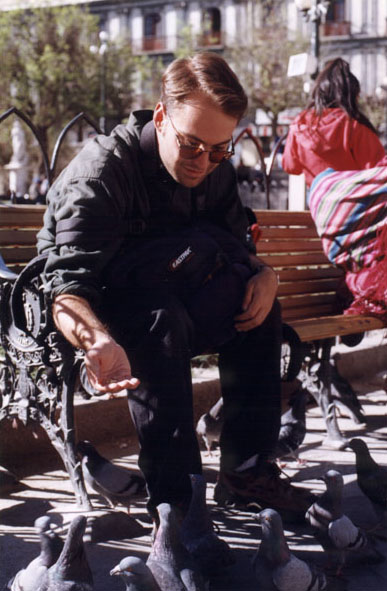 |
| Feeding pigeons at Plaza Murillo |
By late afternoon we returned to Plaza Murillo, which was once again crowded with people along the benches and marble steps. We found a free bench which I claimed while Susanne purchased two bags of corn from a campesina so we could feed the pigeons. A flock of several dozen pigeons settled in front of us, avidly awaiting each handful of corn. Susanne held out her hand with several kernels in her palm. A few moments later a pigeon jumped onto her fingertips and pecked away at the corn. "Now you try it," Susanne encouraged me. The pigeons, it seemed, weren't as enthusiastic about jumping on my hand as they had been with hers, but eventually one bird flapped its wings and perched on my hand, its claws digging into my index finger. Startled by the claws I accidentally scattered the corn, which the pigeon followed in earnest.
"Perhaps this pigeon-in-hand thing isn't exactly for me," I sighed.
Neither Susanne nor I was hungry enough for a full dinner that evening, so we decided to snack at some of the local cafes. First we visited Café Paris, on the far end of Plaza Murillo. Susanne bought a small bag of cookies while I had a brownie. It wasn't the prettiest café in La Paz but the owner and his wife were hanging out with friends up front, so it felt like we were having dessert in a neighbor's kitchen. We then walked downhill to Café Torino, where I'd had breakfast earlier that day. Susanne and I ordered cappuccinos while I also indulged in a large slice of lemon meringue pie. Our waiter wasn't the brightest man in La Paz - first he forgot one of our coffees and then forgot my pie - but at least his errors allowed us to stretch out our stay, talking about our journals and watching people descend the steep hill outside our window.
By 7pm we were ready to return to our hotel. Instead of calling it a night we settled into the hotel restaurant over a couple of Fantas and sketched in our notebooks. Susanne drew a picture of a campesina woman by a door while I worked on a sunset over Lake Titicaca. I practiced on a scrap of paper, blending orange, yellow and red pastels over a sea of blue before attempting a similar picture in my sketchbook. In the end I wasn't very happy with the sunset I drew in the book - a little too forced, I thought, though Susanne disagreed. Practice makes perfect, I suppose. As I cleaned the orange pastel dust from my fingers I realized it was almost 10 o'clock: time to get some sleep in order to wake up early for that tour of Tiwanaku, assuming it wasn't canceled yet again.

